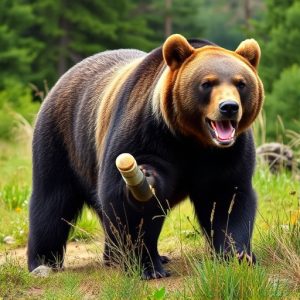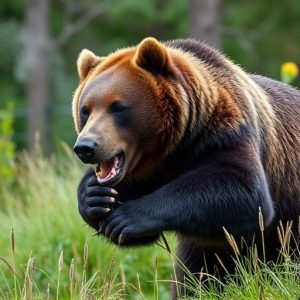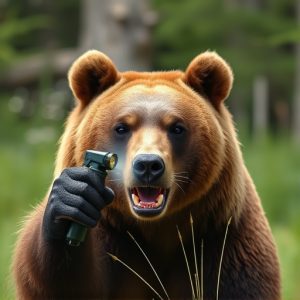Bear Spray Fog Pattern Test: Effective Range & Application Techniques
The Bear Spray Fog Pattern Test is a crucial tool for evaluating bear spray effectiveness, measuring…….
The Bear Spray Fog Pattern Test is a crucial tool for evaluating bear spray effectiveness, measuring its range and distribution in controlled environments. This data guides optimal usage, especially in diverse terrain and wind conditions, to ensure maximum protection against aggressive bears. The test identifies ideal application techniques, with mist/fog patterns offering broader coverage and jet streams providing focused protection. Real-world studies confirm bear spray's high deterrence, altering bear behavior even at low concentrations. Best practices include aiming for the face/chest, maintaining distance, keeping a clear line of sight, regularly testing spray functionality, and combining it with noise makers and bear bells for enhanced safety in bear country.
“Uncover the secrets behind bear spray’s effectiveness with our comprehensive guide. We delve into the science behind the Bear Spray Fog Pattern Test, exploring how this test reveals critical data on its range and performance. From understanding environmental factors to mastering application techniques, we cover it all.
Learn about real-world scenarios where bear spray has proven successful and discover safety measures for responsible use. Get ready to navigate the wilderness with confidence.”
- Understanding Bear Spray Fog Pattern Test
- Factors Influencing Effective Range
- Determining Optimal Application Techniques
- Real-World Scenarios and Case Studies
- Safety Measures and Best Practices
Understanding Bear Spray Fog Pattern Test
Understanding the Bear Spray Fog Pattern Test is crucial for evaluating its effectiveness as a deterrent. This test simulates real-life scenarios where bear spray is deployed, focusing on the fog pattern created by the aerosol. By analyzing the spray’s range and distribution, researchers can determine its optimal usage and the level of protection it provides against aggressive bears.
The Bear Spray Fog Pattern Test involves releasing the spray into a controlled environment, often mimicking dense forest conditions. This allows for precise measurement of the spray’s reach—how far it travels and how effectively it covers an area. The test data helps users understand the critical distance where bear spray can be effective, ensuring they use it appropriately to avoid unnecessary exposure to these powerful animals.
Factors Influencing Effective Range
The effective range of bear spray is influenced by several factors, making it crucial to understand these variables for optimal protection. One key aspect is the spray’s fog pattern test results, which indicate how far and wide the spray can reach. A successful bear spray fog pattern should cover a significant distance, typically ranging from 20 to 30 feet (6 to 9 meters), ensuring that it can deter an approaching bear before it reaches you.
Other factors include environmental conditions such as wind speed and direction, terrain elevation, and the size and strength of the bear. For instance, in calm, flat environments, the spray’s range may be more consistent with ideal test results. Conversely, in windy or uneven terrain, the spray pattern can vary, potentially reducing its effective range. Understanding these influences allows users to make informed decisions when selecting and deploying bear spray for maximum deterrence.
Determining Optimal Application Techniques
Determining optimal application techniques for bear spray is crucial, as it significantly influences its effectiveness as a deterrent. One key factor to consider is the fog pattern created by the spray. The Bear Spray Fog Pattern Test helps assess how far and wide the spray reaches, providing valuable insights into ideal usage scenarios. For instance, a fine mist or foggy cloud pattern suggests better air dispersion, allowing for coverage of a broader area and potentially reaching bears from farther distances.
In contrast, a straight jet stream might offer more focused protection but may not be as effective in open, windy environments. The test results guide users in choosing the right application method based on their location and bear activity patterns. Whether spraying directly towards an approaching bear or using a defensive stance to create a protective fog cloud, understanding these techniques enhances safety measures during encounters in wild environments.
Real-World Scenarios and Case Studies
In real-world scenarios, bear spray has proven to be an effective deterrent in numerous case studies. One notable study conducted by researchers examined the impact of bear spray fog patterns on grizzly bears’ behavior. The test involved simulating encounters in controlled environments, where bears were exposed to different concentrations of bear spray fog. Results showed that even at low concentrations, the spray significantly altered the bears’ behavior, causing them to retreat and avoid the area. This finding highlights the power of bear spray as a non-lethal deterrent, particularly in situations where human-bear interactions are inevitable.
Case studies from outdoor enthusiasts and park rangers further validate the effectiveness of bear spray. Many hikers and campers have shared stories of successfully avoiding aggressive bears by using bear spray strategically. Rangers in regions with high bear populations also report reduced conflict incidents since implementing bear spray as a standard safety measure. These practical applications reinforce the notion that bear spray, when used correctly, can deter bears from approaching and potentially attacking, thus ensuring the safety of individuals in bear country.
Safety Measures and Best Practices
Safety Measures and Best Practices
When considering bear spray as a deterrent, understanding its effective range and fog pattern is paramount for safety. Bear spray creates a disorienting fog that temporarily disables bears through irritation to their eyes, nose, and respiratory system. However, the fog’s effectiveness relies on proper application and awareness of its limitations. The average bear spray can reach an effective range of about 30 feet (9 meters), but this distance can vary based on factors like wind, terrain, and spray type.
During usage, it’s crucial to follow best practices: aim for the face and chest area of the approaching bear, keep a safe distance within the recommended range, and ensure you have a clear line of sight. Regularly test your spray through the Bear Spray Fog Pattern Test to verify its functionality and ensure you’re prepared in case of an encounter. Remember that no single method guarantees 100% protection, but combining bear spray with noise makers, carrying bear bells, and maintaining awareness can significantly reduce risks during outdoor activities in bear country.
The Bear Spray Fog Pattern Test provides valuable insights into the effective range of bear spray, a crucial tool for outdoor enthusiasts and wilderness managers. Understanding how spray disperses and factors influencing its reach ensures optimal protection in potential encounters. By employing the right application techniques and adhering to safety measures, individuals can maximize the deterrent effect of bear spray, enhancing their safety in various real-world scenarios.


